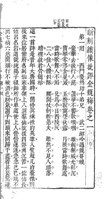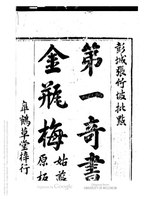Jin Ping Mei
LC Class PL2698.H73 C4713 | | |
Original text | 金瓶梅 at Chinese Wikisource | |
|---|---|---|
| Jin Ping Mei | |
|---|---|
Hanyu Pinyin | Jīn Píng Méi |
| Wade–Giles | Chin1 Pʻing2 Mei2 |
| IPA | [tɕín pʰǐŋ měɪ] |
| Yue: Cantonese | |
| Jyutping | gam1 ping4 mui4 |
| The Scoffing Scholar of Lanling | |
|---|---|
Hanyu Pinyin | Lánlíng Xiàoxiào Shēng |
| IPA | [lǎn.lǐŋ ɕjàʊ.ɕjàʊ ʂə́ŋ] |
Jin Ping Mei (
The explicit depiction of sexuality garnered the novel a notoriety akin to Lady Chatterley's Lover and Lolita in the West, but critics such as the translator David Tod Roy see a firm moral structure which exacts retribution for the sexual libertinism of the central characters.[4]
Jin Ping Mei takes its name from the three central female characters—
David Tod Roy calls the novel "a landmark in the development of the narrative art form—not only from a specifically Chinese perspective but in a world-historical context...noted for its surprisingly modern technique" and "with the possible exception of The Tale of Genji (c. 1010) and Don Quixote (1605, 1615), there is no earlier work of prose fiction of equal sophistication in world literature."[5] Jin Ping Mei is considered one of the six classics of Chinese novels.
Plot

Jin Ping Mei is framed as a spin-off from Water Margin. The beginning chapter is based on an episode in which "Tiger Slayer" Wu Song avenges the murder of his older brother by brutally killing his brother's former wife and murderer, Pan Jinlian. The story, ostensibly set during the years 1111–1127 (during the Northern Song dynasty), centers on Ximen Qing (西門慶), a corrupt social climber and lustful merchant who is wealthy enough to marry six wives and concubines.
After Pan Jinlian secretly murders her husband, Ximen Qing takes her as one of his wives. The story follows the domestic sexual struggles of the women within his household as they clamor for prestige and influence amidst the gradual decline of the Ximen clan. In Water Margin, Ximen Qing is brutally killed in broad daylight by Wu Song; in Jin Ping Mei, Ximen Qing in the end dies from an overdose of aphrodisiacs administered by Jinlian to keep him aroused. The intervening sections, however, differ in almost every way from Water Margin.[6] In the course of the novel, Ximen has 19 sexual partners, including his six wives and mistresses, and a male servant.[7] There are 72 detailed sexual episodes in Jin Ping Mei.[8] However, considering the novel has over one million words (and over 3,600 pages in complete English translation), the graphic sexual scenes accounts for less than 3 percent of its total content.[9]
Evaluation


For centuries identified as pornographic and officially banned most of the time, the book has nevertheless been read surreptitiously by many of the educated class. The early Qing dynasty critic
The American scholar and literary critic
The novel contains a surprising number of descriptions of sexual objects and coital techniques that would be considered
Authorship
The identity of the author has not yet been established, but the coherence of the style and the subtle symmetry of the narrative point to a single author.[16] The British orientalist Arthur Waley, writing before recent research, in his Introduction to the 1942 translation suggested that the strongest candidate as author was Xu Wei, a renowned painter and member of the "realistic" Gong'an school of letters, urging that a comparison could be made of the poems in the Jin Ping Mei to the poetic production of Xu Wei, but left this task to future scholars.[17]
The "morphing" of the author from Xu Wei to Wang Shizhen would be explained by the practice of attributing "a popular work of literature to some well-known writer of the period".[18] Other proposed candidates include Li Kaixian and Tang Xianzu. In 2011, Zhejiang University scholar Xu Yongming argued that Bai Yue was possibly the author.[19]
The novel contains extensive quotations and appropriations of the writings of other authors. According to The Cambridge History of Chinese Literature, Jin Ping Mei's sources include vernacular stories, pornography, histories, dramas, popular songs, jokes, and prosimetric narratives, as well as texts far outside of the parameters of the literary, such as official gazettes, contracts, and menus."[20]
Translations
English
1610 version
- ISBN 0691125341. 5 volumes. 1993–2013. A complete and annotated translation of the 1610 edition presumed to be closest to the author's intention.[21]
1695 version
- ISBN 9780710073495. 4 vols. Internet Archive, HERE. Various reprints.
- Egerton worked with the celebrated Chinese novelist ISBN 9780804841702), with a General Introduction by Robert E. Hegel.
- Egerton worked with the celebrated Chinese novelist
- Bernard Miall, translated from the German of Franz Kuhn with an Introduction by Arthur Waley. Chin P'ing Mei: The Adventurous History of Hsi Men and His Six Wives. (London: John Lane, 1942; rpr. New York, Putnam, 1947).[22]
Other Languages
- The book was translated into Manchu as ᡤᡳᠨ
ᡦᡳᠩ
ᠮᡝᡳ
ᠪᡳᡨᡥᡝ Wylie: Gin p'ing mei pitghe, (Möllendorff: Gin ping mei bithe) and published in a bilingual edition as early as 1708.[23] The title is a phonetic transcription of each syllable in the Manchu script, rather than a translation of the meaning. It has been digitized by the Documentation and Information Center for Chinese Studies of Kyoto University and is available online. - La merveilleuse histoire de Hsi Men avec ses six femmes. Translated by Jean-Pierre Porret. (Paris: Le Club Français du Livre, 1949 – 1952, reprinted, 1967). 2 volumes.
- Djin Ping Meh: Schlehenblüten in Goldener Vase: ein Sittenroman aus der Ming-Zeit, translated by Otto and Artur Kibat. 6 volumes. (Hamburg: Die Waage, 1967–1983). Uses the 1695 recension.
- Fleur en fiole d'or, Jin Ping Mei Cihua. Translated and annotated by ISBN 2-07-031490-1. The first translation into a Western language to use the 1610 edition, but follows the 1695 edition in omitting many of the longer song suites and other borrowed material.[24]
- Jin Ping Mei en verso y en prosa. Complete Spanish translation. Translated and annotated by Alicia Relinque Eleta. Atalanta. 2 volumes (2010, 2011). ISBN 9788493778477, 8493778478.
- Complete Russian translation, 5 volumes, 1994—2016: Цзинь, Пин, Мэй, или Цветы сливы в золотой вазе. Т. 1—3. Иркутск: Улисс, 1994. 448+512+544 с. ISBN 978-5-89282-697-6
-
A Chinese edition of the novel
-
An illustration of a fireworks display from a 1628–1643 edition of Jin Ping Mei from the Ming era.[25]
-
Another edition of Jin Ping Mei from the late Ming era
-
Title page of the novel from a printed edition
Adaptations
- The Concubines (Japan, 1968)
- The Golden Lotus (Hong Kong, 1974)
- Ban Geum-ryeon (South Korea, 1982)
- The graphic novelist Magnuscreated a truncated graphic novel loosely based on the Jin Ping Mei, entitled the 110 Sexpills which focused on the sexual exploits and eventual downfall of Ximen Qing (albeit with the surname being taken as the character's given name, and vice versa).
- The Japanese manga by Mizukami Shin 金瓶梅・奇伝 炎のくちづけ (Kinpeibai Kinden Honoo no Kuchizuke) is loosely based on Jin Ping Mei. (2004)
- The Forbidden Legend Sex & Chopsticks (Hong Kong, 2008)
- Golden Lotus (musical; premiered in 2014)
See also
Notes
- ISBN 0-7007-0439-6, pp.163–164
- ^ a b Lu (1923) p.408
- ^ Roy (2006), p. xx–xxi.
- ^ Charles Horner (October 1994). "The Plum in the Golden Vase, translated by David Tod Roy". Commentary Magazine.
- ^ Roy (2006), p. xvii–xviii.
- ^ Paul S. Ropp, "The Distinctive Art of Chinese Fiction," in Ropp, ed., The Heritage of China: Contemporary Perspectives on Chinese Civilization. (Berkeley; Oxford: University of California Press, 1990), pp. 324–325.
- ISBN 9780520078697.
- ^ Ruan, Matsumura (1991) p. 95
- ^ Ruan, F; Matsumura, M (1991). Sex in China: Studies in Sexology in Chinese Culture. New York: Plenum Press. p. 101.
- ^ a b Wai-Yee Li, "Full-Length Vernacular Fiction," in V. Mair, (ed.), The Columbia History of Chinese Literature (NY: Columbia University Press, 2001). p. 640-642.
- ^ Lu Xun. A Brief History of Chinese Fiction (1923; Foreign Languages Press, 1959). Translated by G. Yang and Yang Xianyi. p. 232, 235.
- ^ Andrew H. Plaks, Four Masterworks of the Ming Novel. (Princeton, New Jersey: Princeton University Press, 1987), esp. pp. 497–98.
- ISSN 0147-037X.
- JSTOR 1769184.
- ^ Sun, Phillip S. Y. (Autumn 1985). "The Structure and Achievements of Jin Ping Mei" (PDF). Renditions: 102–108.
- ^ Li (2001), p. 637-638.
- ^ Arthur Waley, "Introduction," to Shizhen Wang, translated from the German of Franz Kuhn by Bernard Miall, Chin P'ing Mei: The Adventurous History of Hsi Men and His Six Wives. (London: John Lane, 1942; rpr. New York, Putnam, 1947.
- ^ Liu Wu-Chi. An Introduction to Chinese Literature.[page needed]
- JSTOR 41412920.
- ISBN 9780521855587.:107
- ^ Horner (1994).
- ^ The Putnam edition was first published in two volumes in 1940, thus the 1942 and 1947 dates are incorrect. The 1947 printing was in one volume and is considered to be inferior to the 1940 two-volume edition. Oddly, however, the Waley introduction in the 1940 edition does not mention either translators, Kuhn or Miall, as the sources of the English version.
- JSTOR 2719468.
- ^ Roy (2006), p. xxi.
- ISBN 0-521-30358-3.
References and further reading
- Hegel, Robert E. (2011), "General Introduction", The Golden Lotus: Jin Ping Mei, vol. I, Tokyo; Brattleboro, Vt.: Tuttle, pp. 5–21, ISBN 9780804841702
- C. T. Hsia, Ch. V "Chin Ping Mei", in The Classic Chinese Novel: A Critical Introduction. (1968; rpr. Ithaca, N.Y.: East Asia Program, ISBN 1885445741.
- Li, Wai-Yee (2001), "Full-Length Vernacular Fiction", in Mair, Victor (ed.), Columbia History of Chinese Literature, New York: Columbia University Press, pp. 620–658, ISBN 0231109849esp. pp. 639–643.
- Lu, Hsun (1923). ISBN 0-89875-154-3.
- Andrew H. Plaks. The Four Masterworks of the Ming Novel: Ssu Ta Ch'i-Shu. (ISBN 0691067082.
- Qi, Lintao (17 December 2019). Jin Ping Mei English Translations Texts, Paratexts and Contexts. Taylor & Francis. ISBN 9780367892975.
- Roy, David Tod (2006), "Introduction", The Plum in the Golden Vase, or, Chin P'ing Mei Vol I The Gathering, Princeton, N.J.: Princeton University Press, pp. xvii–xlvii, ISBN 0691069328
- Schonebaum, Andrew, ed. (2022). Approaches to Teaching the Plum in the Golden Vase (The Golden Lotus). New York: Modern Languages Association. ISBN 9781603295444. Essays.
- Song, Chundan; Xie, Ying (January 2017). "More Than Sex". NewsChina. Vol. 101. pp. 52–55.
- Spence, Jonathan(1994). "Remembrance of Ming's Past". The New York Review of Books. 23.; archived at NYRB China Archive "Remembrance of Ming's Past".
External links
- Sample of a chapter from David Tod Roy's translation
- Research articles (Chinese)
- Interview with David Tod Roy By Carla Nappi (December 16, 2013)
- Jin Ping Mei at Project Gutenberg (Chinese)


![An illustration of a fireworks display from a 1628–1643 edition of Jin Ping Mei from the Ming era.[25]](http://upload.wikimedia.org/wikipedia/commons/thumb/e/ed/Ming_Dynasty_Jin_Ping_Mei_fireworks.jpg/156px-Ming_Dynasty_Jin_Ping_Mei_fireworks.jpg)

